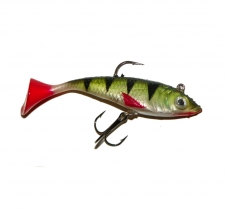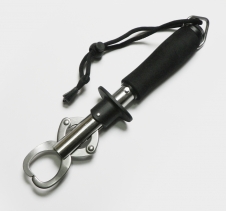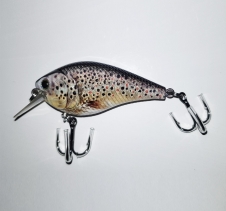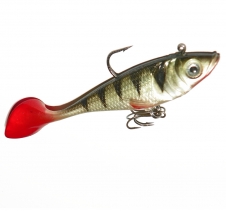Visit Our Online Store! $7 AusPost Parcel Post Delivery FREE Postage for orders $45 and over!
* Shipping rates above apply to Australian Customers only
Macquarie Perch, our most beautiful perch in the most danger.
Macquarie Perch fishing history, historical stocking information, fishing locations and bait advice.
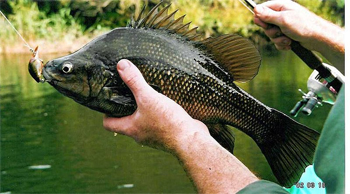 A beautiful native fish in the Macquaria genus, related to yellowbelly (Golden Perch), estuary perch and Australian bass. Their shape is similar to a cross between estuary perch and yellowbelly. In mature fish the dorsal section arches upwards heavily just after the head, and from this the adults can take on a look closer to yellowbelly. The exception however is while the shape of yellowbelly tends to expand outwards with age, giving them the nickname 'footballs', Macquarie Perch do not extend outwards anywhere near as much, and stay closer to estuary perch or bass in total mass. The weight of adult Macquarie perch averages around 2kg.
A beautiful native fish in the Macquaria genus, related to yellowbelly (Golden Perch), estuary perch and Australian bass. Their shape is similar to a cross between estuary perch and yellowbelly. In mature fish the dorsal section arches upwards heavily just after the head, and from this the adults can take on a look closer to yellowbelly. The exception however is while the shape of yellowbelly tends to expand outwards with age, giving them the nickname 'footballs', Macquarie Perch do not extend outwards anywhere near as much, and stay closer to estuary perch or bass in total mass. The weight of adult Macquarie perch averages around 2kg.The colour is the most attractive part of these fish, they are a very dark bluish-grey at the top with yellowish (almost golden) lower scales located towards the lower rear of the fish. The fins at the rear of their body are very dark and purplish, while the front fins can be a mixture of pink with strong black features.
Their native habitat is within the Murray Darling system, although their numbers are now extremely low. Currently the fish are listed as endangered in Australia, however further research is expected to reveal the fish as actually being critically endangered.
Macquarie perch fishing is not allowed in New South Wales and Victoria, and any fish caught must be returned to the waters unharmed. The only exceptions to the Victorian rules are for fish caught in Lake Dartmouth (Located between Dartmouth and Benambra), the Upper Coliban Reservior (Kyneton) and the Yarra River (Warrandyte and further east, heading away from Melbourne). These waterways have a closed season for Macquarie Perch throughout all of October, November and December.
Macquarie Perch located in the Yarra River are not in their native habitat, they were actually introduced in 1857 by a man named Edward Wilson, who transported both Murray Cod and Macquarie Perch fingerlings in tin cans, by horse and cart from their native collection point of King Parrot Creek in Kerrisdale (Near Seymour) to the Plenty River just outside of Whittlesea. From there they were released and expected to eventually migrate to the Yarra River near Bulleen / Templestowe, where it was hoped they would propagate and multiply throughout most of the Yarra. In 1862 the project was proven a success, as the first Murray Cod at 1 foot long was caught in the Yarra River. Macquarie perch catches in the Yarra today are not uncommon.
Macquarie Perch were also stocked to the Barwon and Moorabool Rivers in Geelong, although the last official catch from these waters is quoted as 1938 in Geelong and 1931 in Winchelsea. Private records however show the river was still being recommended for Macquarie Perch fishing as late as 1961. Within these river systems around Geelong, the introduced Macquarie Perch populations are now expected by most to be extinct, but with no official surveys completed to specifically determine this, it is an unknown as to whether they still exist somewhere within these rivers today.
Fishing for them in the Yarra River can be enjoyable, and their minimum legal size for taking in this location is 35cm. A maximum of two fish over this size are allowed to be dispatched and taken, although we urge you to strongly consider catch and release fishing due to their overall endangered situation. Macquarie Perch fishing in the Yarra is likely only allowed due to their introduced status, if they were in their native range fishing for them would not be permitted.
The common baits for Macquarie (or Maccas as some call them) are worms and yabbies, but maggots are often considered the best bait of all. If you are brave enough to use maggots, throwing a small handful into the water near where you cast your hook can get the macquaries feeding. Hook sizes recommended are anywhere between size 10 (small) to 4 (medium). Between 2 and 4 maggots can be placed on a hook, a running sinker set up is recommended using a 1 meter 7lbs (3kg) leader.
Macquarie Perch will take most diving hard body lures along with spin lures, they can however be difficult to catch on lures as they prefer to travel and feed at the sides of the water rather than in the middle where the faster flow occurs. Getting a lure travelling along the bottom of the river bed near the bank is often the best way to catch them, this is made easier if the river is wider with a sloping drop to the deeper waters in the center.
A lot of patience is often required when you have hooked onto a Macquarie, as they have a tendency to run immediately into the faster flowing waters and then stop, if you are impatient the fish can get the better of you, and in trying to force the fish towards you, the hook can be drawn from their mouth. In the same way, if you loosen the slack on them too much, the fish can run and break itself free. Keeping the line tight but not too tight and gently applying a little more pressure every so often can be an effective way to coax the fish into moving, which will then allow you to continue the retrieve.
* Information in this article was prepared in August, 2014. State based legal requirements may be subject to future changes.
Follow us on twitter: @FishTackleLures or Google Plus: +FishingTackleLuresAU
View more articles in our Australian Fishing Guide.
Enter your email address below to be updated on new fishing articles, fishing lures and special offers:
We will only email once every two to four weeks at the most, usually every 2 months.
POPULAR PRODUCTS IN OUR ONLINE STORE


